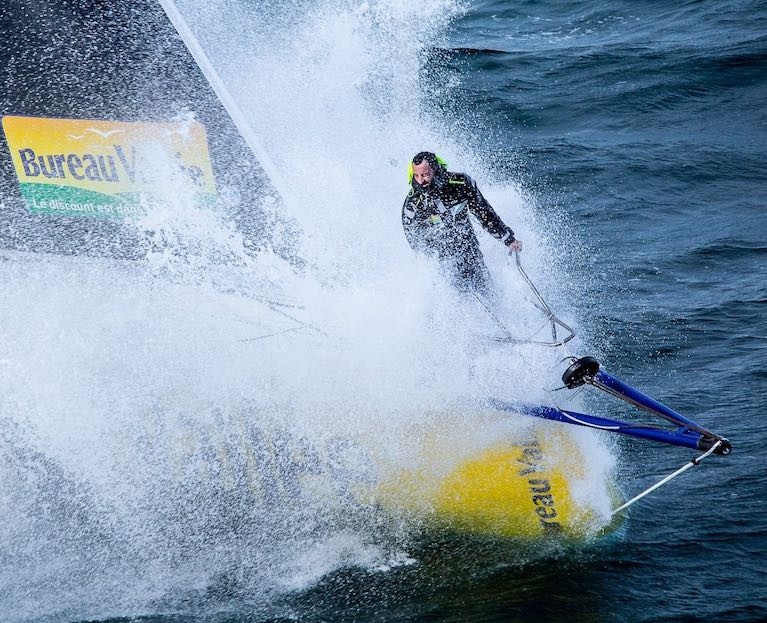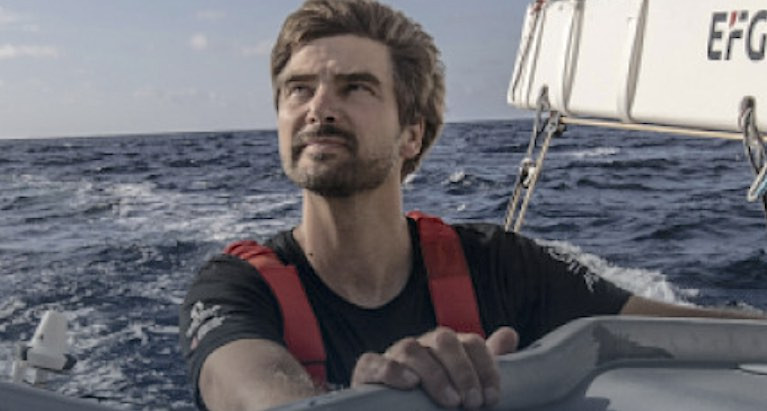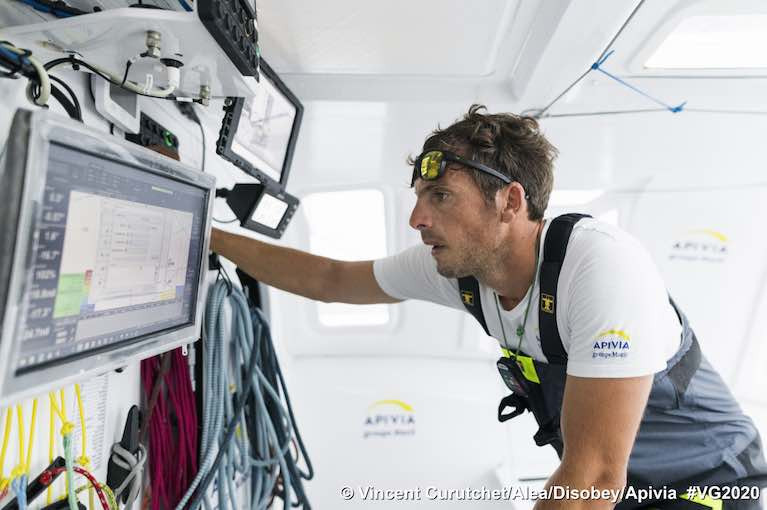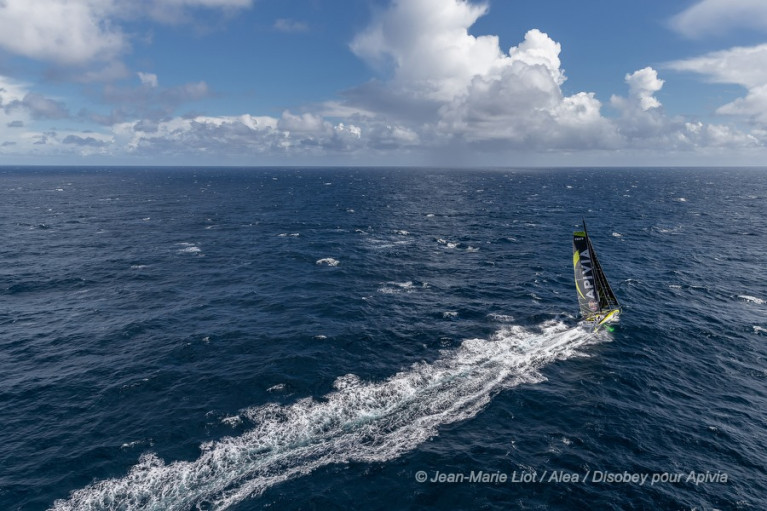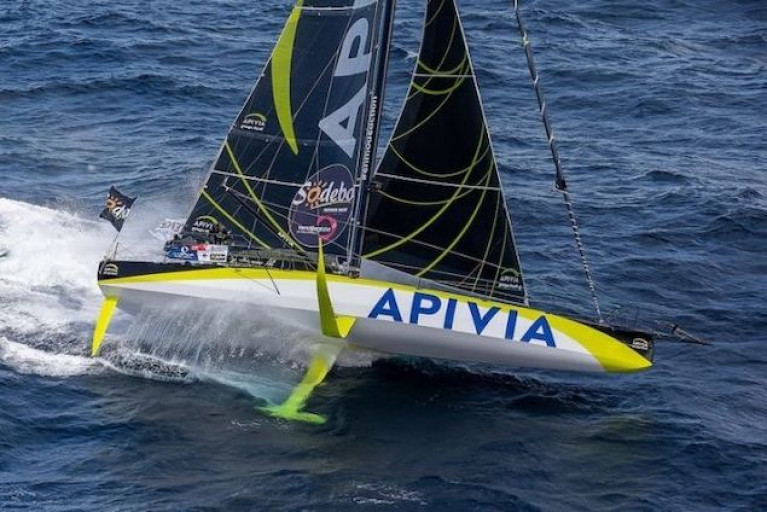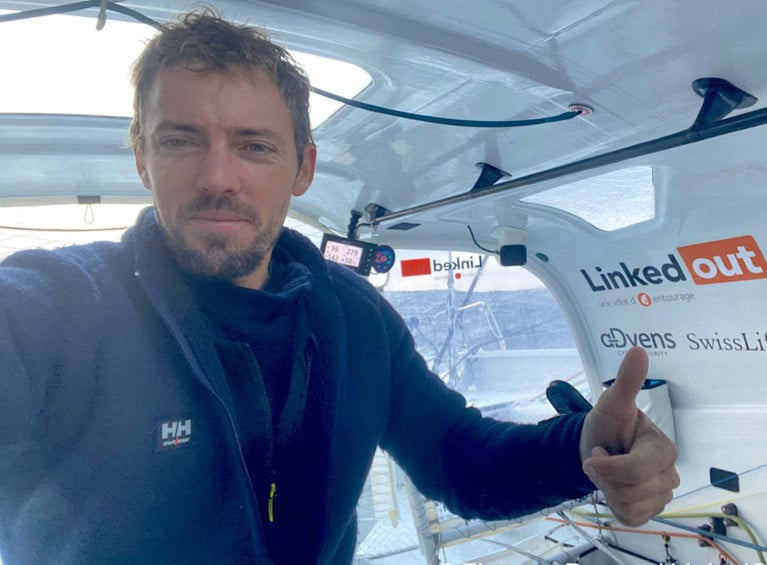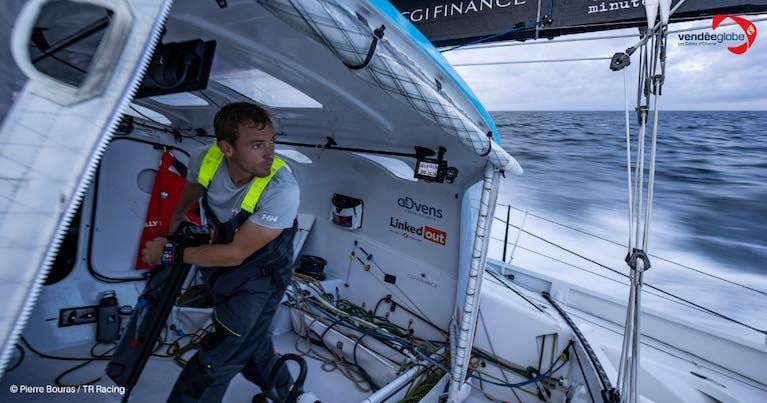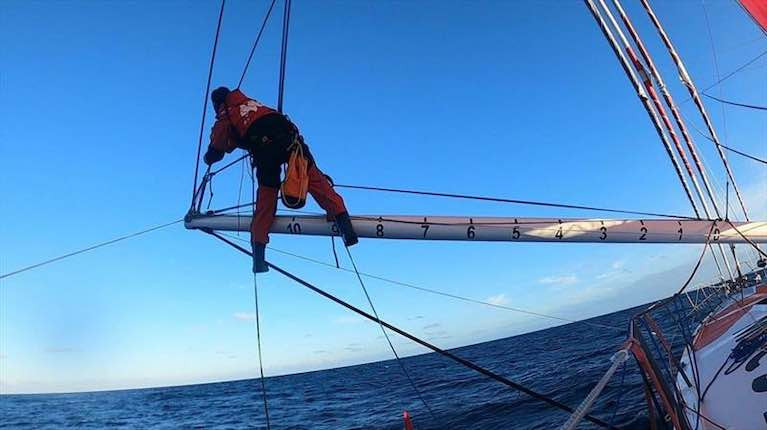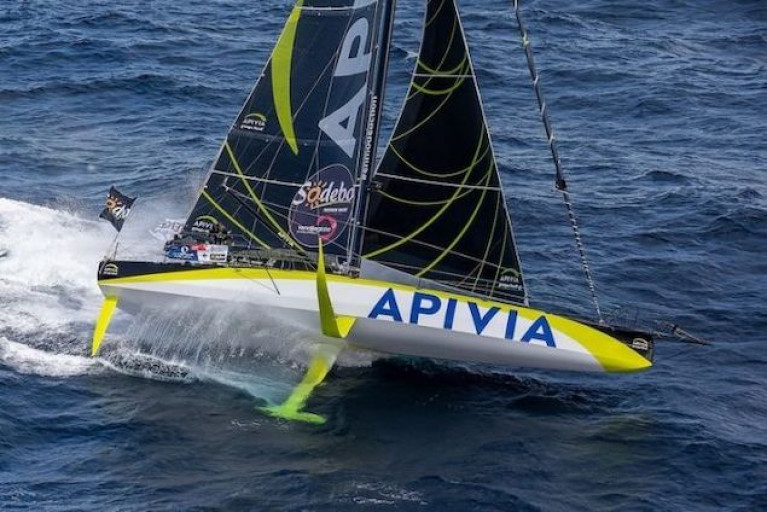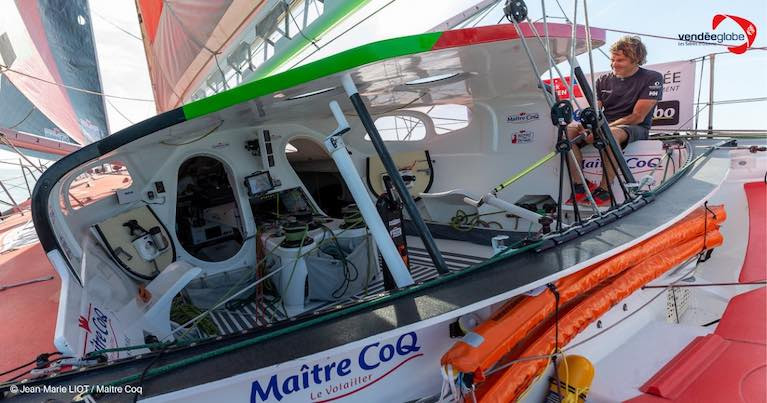Displaying items by tag: Vendee Globe
Vendee Globe Leaders Dalin v Burton Side by Side Into Doldrums
(Day 70, Leaders just past Fernando de Noronha) ‘Considering the speed that phenomena evolve in the Doldrums a little luck is always needed’ - Vendée Globe meteo adviser Christian Dumard annexes his prediction for the Vendée leaders’ passage of the ICTZ with a warning.
Even with all of the tools and assimilated knowledge, no doubt enhanced during last winter and spring’s lockdown learning phase in Europe, the passage of the Inter-Tropical Convergence Zone’s unexpected squalls, prolonged calms under clouds, and variable, shifting winds – is always a time of high tension for Vendée Globe skippers.
But for the tightly matched leading group of six skippers, time micro-analysing the latest files, data and images, is every bit as important as keeping the boat fast.
On the latest models the doldrums are more active than expected. The critical convection zones have grown and become more numerous. The skippers need to watch the evolution and the movement of these cells which are not small isolated squalls, They can quickly and unexpectedly grow to be several tens of miles or even several hundred miles.
To monitor these the skippers use real-time satellite images which show large clusters of clouds. Forecast models have improved a lot and can model areas with light winds better now, as well as the areas with the risk of heavy rains. Big clouds usually mean heavy rain, wind convection and calms are possible with strong gusts at the edge of the clouds. They can look to thunderstorm forecasts from the European Prediction Center. This index has only been available for a few years. They can and will look at currents that can bring warmer waters which create more convection and as well convectivity indices provided by the models.
Weather expert Dumard notes, “The models are not all created equal. The finer the mesh the better the forecast. It must also take into account the temperature of the water as well. In this game, the data from the European model (ECMWF) which offers a resolution of 9 km, available to the public on Windy, is often the most efficient.”
Charlie Dalin and Louis Burton have a west-east separation of just 25 miles late this afternoon. In fact Burton is further north than the nominal leader Dalin on Apivia while the skipper of Bureau Vallée 2 is quicker all the time as the two yellow-hulled IMOCA’s reach northwards in an SE’ly trade wind at speeds around 19-20kts.
At the time of writing it was probable that Burton would lead across the Equator early this evening, marking something of a triumphant return after the skipper lost miles to the peloton repairing at Macquarie Island and going on to round Cape Horn in ninth more than 550 miles behind Dalin. And it will be the second time in consecutive races that this boat has led the Vendée Globe back into the northern hemisphere after 2016-17 winner led, en route to victory.
Computed to be just a couple of miles apart in terms of distance to the finish line at Les Sables d’Olonne’s Nouch Sud buoy, the two leaders saw Germany’s third placed Boris Herrmann re-adjust his track to the west overnight and this morning. He has picked back up to speed, pacing Burton at just over 20kts, but still promoting speculation that Herrmann might not, after all, have all his sail inventory intact.
Speaking of Herrmann on this afternoon’s Vendée Globe Live show in English Charlie Dalin said: “He is positioning for the doldrums and maybe the scenario afterwards, the doldrums will be a bit less active further west but after that it is harder to say, but we will see who is right in 36 to 48 hours. We will see. We should be out or nearly out. I believe he has a full foil and is a strong contender in to the finish but I don’t believe any boat is at 100 per cent of its potential. I don’t believe he will be at 100 per cent, everyone will have their problems, sails, electronics, hydraulics. I think everyone has some problem at this stage of the race."
Destremau (Merci) forced to retire
Sébastien Destremau, the skipper of the 26th placed IMOCA Merci, has been finally forced to abandon his attempt to complete his second Vendée Globe.
Destremau, the 46 year old skipper from Toulon, has had a succession of problems since he was in the North Atlantic, most recently in the Indian Ocean with his autopilots and his steering system.
Although he was this afternoon less than 60 nautical miles from Dunedin, South Island New Zealand, the skipper of Merci plans to continue to Christchurch where there are better facilities to repair. After his consecutive problems he was nearly 7,500 miles behind the leader, but more particularly Destremau was nearly 2,000 miles behind 25th placed Ari Huusela
Sam Davies Cameo Appearance
A somewhat unexpected surprise for Vendée Live viewers today was a cameo appearance from Sam Davies who gave a brief update from Initiatives Coeur. Davies had to retire into Cape Town but restarted and is continuing her circumnavigation outwith the Vendée Globe, sailing close to Alexia Barrier recently
"It is nothing like being in the Vendée Globe and frustrating to be so far behind but it is amazing to continue the adventure and to continue to be here especially for Initiatives Coeur and all the children I am helping. I have had a lot of feedback and I know we have raised a lot of money since I restarted in Cape Town.
I have been in touch with Miranda (Merron) we have a little ritual to get together on WhatsApp and we have both a few beers on our boats and choose Friday nights to drink a beer together on WhatsApp. I have been in touch with Alexia as we are in close together and in the same weather systems so it is nice to have people around me. It was lonely having started again from Cape Town but it is better now.
It is really hard to motivate myself, yes, especially when the group I imagine I would have been with went around Cape Horn and headed off up the Atlantic as I was just then into the Pacific and so there was an ocean between us.”
Ranking at 17:00 UTC
1. Louis Burton [ Bureau Vallée 2 ]—> 3,326.13 nm from the finish
2. Charlie Dalin [ Apivia ] —> 3.07 nm from the lead
3. Boris Herrmann [ SeaExplorer - Yacht Club de Monaco ]—> 43.58 nm to leader
4. Thomas Ruyant [ LinkedOut ] —> 98.13 nm to leader
5. Damien Seguin [ Groupe Apicil ] —> 120.37 nm to leader
German Vendee Globe Skipper Boris Herrmann is Growing Threat to Leader
Racing now with less than 160 miles to go to pass Recife on the northeasterly corner of Brasil, Vendee Globe leading duo Charlie Dalin and Louis Burton will be starting to recognise a threat from German skipper Boris Herrmann as he moved into third place overnight Thursday and is now just 39 miles behind Dalin and 17 behind Burton;
The 37-year-old from Hamburg has been quickest of the top group overnight, profiting especially from his position with Seaexplorer Yacht Club de Monaco slightly further offshore than Dalin and Burton – about 30 miles – but more particularly because he has a pair of larger, new generation, working foil on his IMOCA 60, which were upgraded last March, and he has consistently reported that he has a full armoury of largely undamaged sails. Herrmann was quicker than leader Dalin this morning by two knots and in theory his gains should continue at least until the transition zone off Recife where the wind could be lighter depending on the time of day the leaders pass.
Herrmann has played to a patient, careful strategy in the Southern Oceans looking to preserve his material as best as possible, staying out of the worst of the winds in the extreme south but pressing for high average speeds from his VPLP-Verdier IMOCA which was built as Edmond de Rothschild and skippered by Sébastien Josse in the last race. In 2016 the French skipper retired in the south with multiple problems. With two racing circumnavigations under his belt already Herrmann was 12th in the Transat Jacques Vabre in 2019 and seventh in last year’s solo Vendée Arctic Les Sables d’Olonne warm-up race. It would not be a surprise to see the German skipper leading the fleet after leaving the Brasilian coast. But the route north is not as simple as it maybe seemed.
The Doldrums extend from about 0 ° 30 South to 3 ° 30 North, that is to say about 200 to 250 miles wide at 33 ° West but it is maybe not as narrow and easy as some have been suggesting. There are a few storm cells forming and the cloud mass appears very dark. The trade winds in the Northern hemisphere seem to converge with those of the Southern hemisphere to generate an approximately easterly flow for the weekend.
But the after the hard, bouncy slamming climb up the NE’ly trades to the Cape Verde archipelago the big question arises about crossing a transition zone, a wide anticyclonic ridge of light winds which will stretch from the Canaries all the way across the Atlantic which must be crossed. And so while there has perhaps been a supposition that the Vendée Globe podium might be decided among the top six just now within 85 miles of each other this morning there are three more behind between 150 and 225 miles behind, including Jean Le Cam in ninth. And the time compensations for the search and rescue of Kevin Escoffier, 6 hours to Herrmann, 10hrs 15 to Yannick Bestaven and 16hrs 15mins to Le Cam may yet prove crucial.
Dalin & Burton 20 Miles Apart in Vendee Globe Leaders Match Race
Today passing Salvador de Bahia, Brazil, there are no options in terms of strategy and choices on the northwards climb up the Atlantic for the tightly matched Vendée Globe leaders. But the conditions are difficult and tiring. The E’ly tradewinds shift in direction and more particularly in strength and that is proving especially wearing, with squalls and gusts which make setting the optimum sail difficult on the close reach.
Apivia skipper Charlie Dalin who has led now for two days is 20 miles ahead of second-placed Louis Burton on Bureau Vallée 2. The pair have been consistently quicker than the four other key rivals round about them.
One month ago when he was SW of Tasmania Dalin had to repair the bearing which secures the foil as it enters the hull aperture on his port side. He is paying a price for not having full use of the large hydrofoil as he tries to get away from Burton who is racing a 2016 generation boat, but the leading skipper remains objective:
“I have to fight with the weapons I have.” He told the Vendée Globe Live show today, “One month ago I came close to abandoning so I am just glad to be here, but we will be on starboard for a long time for sure and it has already started. I'm not sure we don't have to tack in the Doldrums because it looks rather interesting and challenging right now. There will be a lot of sail changes to be made, reefing so that will inevitably play out. But overall there is a lot of starboard tack in the trade winds of the northern hemisphere. The routing of the Doldrums appears to be quicker and easier in theory than in reality so we have to be wary of any timings,” warned the French skipper who grew up in Le Havre and was French Offshore Champion in 2014 and 2016.
“I cannot fully deploy my foil but I can press on it at a certain heeling angle and more so I have a little bit of downforce but nothing like I would normally have had if it were fully deployed. The speeds that I could be at without this compromise are nothing like those I am sailing at now, but, hey let us keep it in perspective because my Vendée Globe could have stopped in Australia or new Zealand but here I am one month on, leading the race. This is just a bonus! It is great! I am very happy and I will do everything to keep the lead and get to the end”.
For all that, Dalin has been quicker during today making 16kts, only outpaced by Germany’s Boris Herrmann who is steadily coming into his own now as the winds build to more consistent foiling conditions. The sailor from Hamburg is up to fifth place and was making 17kts this afternoon, but at the same northing, the same latitude, as former leader Yannick Bestaven who lost 435 miles to the chasing pack in the transition through the Cabo Frio cold front, and is sixth this afternoon.
“Being fifth is a bit nominal, north-south Yannick and I are in the same position. It must be tough for Yannick I feel a bit sorry for him, but I hope he catches up and we all make it a good race together, it's exciting. Thomas Ruyant said he can see us all finishing on the same day, that would be really cool!” explained Herrmann this afternoon,
“Last night was really bad. I had a 26-knot gust and was afraid of breaking stuff and so I feel a bit knackered, tired. It is not as warm as two days ago when it was super warm, unbearable. During the daytime in the bunk, I don’t sleep, I just get a headache. There are little things to complain about, but the race is absolutely amazing, fantastic. You almost wish to accelerate this game, like a time-lapse to see what happens. I am hoping to keep making miles but that is not so much in my hands. Some good wind tomorrow should allow me to foil towards the front.”
Weather routings have the leaders crossing the Equator Saturday before breaking into the NE’ly trades. A transition zone around the south of the Azores high pressure could be the only minor pothole on what looks to be a quick passage to Les Sables d’Olonne.
Vendee Globe Leaders Drag Race Up The Brazilian Coast
With nothing more than a handful of small miles separating them, the leaders of the Vendée Globe are engaged on a straight head-to-head speed test which may yet prove decisive, and which may finally show the ultimate value of a fully functioning latest generation foil package.
In what is likely to be a close reaching then reaching drag race up the Brazilian coast past Recife, 600 miles to the north of leader Charlie Dalin (Apivia), the actual speed potential – the combination of a working foil and J2 headsail – could deliver the key advantage which might then be carried into a North Atlantic sprint finish that presently looks relatively fast and straightforward.
Dalin, from his position about 60 miles to the East of Yannick Bestaven, has managed to eke out a gain to be 10 miles ahead Maître CoQ IV, sailing a faster angle with slightly more wind pressure. Louis Burton is holding steady in third at 23 miles behind.
In terms of the various packages, Maître CoQ IV has smaller less powerful foils as does Burton on Bureau Vallée 2. It is not completely clear if Dalin’s port side foil is compromised because of his repair to the box bearing. In fourth Thomas Ruyant has a truncated foil and lacks power. And already sixth place Boris Herrmann with big, new generation foils fitted to his 2016-17 boat is pulling back miles on Damien Seguin’s Groupe APICIL, first daggerboard boat which is tracking furthest to the East.
Speaking of what he considers to be his potential Boris Herrmann said early this afternoon, “I am normally a humble person but here I would say in theory our boat should have the best potential for the next eight days on starboard tack where I have a proper full port side foil, which should be better and more efficient than Louis Burton and Maître CoQ IV. I suppose, I don’t know how Apivia will go, it may be the fastest but we have really good potential in this boat, but it is now really in the hands of the weather scenario as well, how much the bungee stretches out and in what sequence and if we find the wind to use the foil and when. If it is 11-12kts and 13-14kts then we are onto the foil and can zoom up to the others.”
IMOCA Class president Antoine Mermod gave his own evaluation on the English Live show today, declaring the game wide open,
“It is hard to know what the real state of each boat is. It is sure you need to have the best package for the next eight days on starboard tack, that means a good foil working well and a J2 (main genoa headsail) working well. I think for Thomas Ruyant we know he can’t use it and then I think it will be painful for him. And for Maître CoQ IV close to the lead he is ready to do well but with a small foil but with a good overall package. And from that point of view Boris with big foils and a J2 is in a good position. Remember that a one or two knot speed differential over 24 hours represents a big gain in this context.”
And while it is mostly going to be a speed race in the trade winds to the Doldrums at least, closer to the Brasilian coast there is more potential for disruptive rain squalls and also lighter spells of wind especially at night and in the early morning. This may especially be the case close in to Recife. But in the North Atlantic there seems to be the potential reward of a low pressure system for the leaders to hook into fast SW’ly winds which might offer a record paced passage from the equator to Les Sables d’Olonne.
Surveying the sunshine, the light trade winds the closeness of the fleet and the intensity of the race to the finish, Herrman smiled. "It's kind of the same sailing conditions as when we train in Port-La-Forêt. The sea is flat, the wind is light, I have the impression of being in Brittany.”
He added, “Yesterday evening my routing with the GFS (American weather model) shows us getting to Les Sables d'Olonne in 13 days. Whatever it is, that is good for morale.”
According to Vendée Globe weather consultant Christian Dumard although there have been long sections of what would be considered atypical weather on this race – not least a complicated descent into the Roaring 40s and a long spell of light weather in the Pacific – it appears the North Atlantic might finally deliver a climb back to France direct from the roadbooks, the NE’ly trades transitioning straight to a low pressure system.
Dumard concludes, “We could be looking at long starboard tack in the NE’ly trade winds up to the Canaries, a depression to hang on and a good SW’ly flow to reach Les Sables d'Olonne. It could be quick… ”
(Day 66, 250 miles east of Rio) After 65 days racing and over 23,000 nautical miles sailed on the course, the Vendée Globe in effect restarted off Rio de Janeiro, Brazil today with the five top boats regrouping within 26 miles of each other in terms of the distance to the finish line in Les Sables d’Olonne.
Charlie Dalin (Apivia) has taken the lead again from Yannick Bestaven, the French skipper of Maître Coq IV who lost the biggest leading margin of the race, over 435 nautical miles. But the 48-year-old skipper from La Rochelle has found breeze this afternoon, closer to the Brazilian shore, and is marginally further north than the Apivia sailor.
Dalin, Bestaven, double Parlympic gold medallist Damien Seguin (Groupe APICIL), Thomas Ruyant (LinkedOut) and Louis Burton (Bureau Vallée 2) are compacted tightly off the Brasilian coast, trying to climb into the Easterly tradewinds which are not at all well established at least until the NE’ly corner at Recife.
“The route to the north is anything but clear. Until Recife, the northeast trade winds are unstable, there are bubbles with less wind, and variations in strength and direction. On the water, there must be pressure differences and therefore speed differences between the boats. It is not at all easy,” Sébastien Josse, the weather consultant for the Vendée Globe explained this morning.
And from now to the finish in Les Sables d’Olonne it seems certain the final 4600 miles will be contested with the intensity of an inshore coastal race where every mile counts. And the tiny gaps – there are just 127 nautical miles back to ninth placed Jean Le Cam (Yes We Cam!) – suggest this epic ninth edition of the Vendée Globe may see places decided on a photo finish.
Dalin warned this morning, “Nothing is settled yet, the wind is not at all established in this area where I am sailing. I still see 24 hours of winds which remain unstable in terms of strength and direction. As we are not yet into the more constant wind there are still lots of things going on. I don’t think it will be until Wednesday morning on the early rankings that we will really see things settle a bit.”
He added, “I'm glad I got back into this. Four days ago, I was 450 miles behind. If I had been told then that I would take the lead four days hence I would not have believed it. It is great to have had this opportunity.”
Dalin casts his eye over his title rivals and remarks, “The condition of the boats will matter. I suspect that not everyone is at 100%, no one really is, but who has what? I know what I have: I am handicapped by my port foil. We'll really see what that means when the wind sets in, so don't lets jump to any conclusions right now. We will see if the real performance against these guys is affected. I touch wood, I have no sails problems. I hope it lasts ! "
Bestaven, in second this afternoon, said: “It is a complicated day both in the East and in the West. I thought at the beginning that by being more West, I might be the first one to get out, but I can't say, from one weather file to the other, because it changes in all directions. I'm here because it’s where I could go with the wind there was in the soft zone. I'm making "small gains" trying to get closer to the direct route. I’ll get back in the race when I have more established winds. The sea is fairly crossed, which shakes up the whole boat and reduces the speed a lot as soon as you fly forwards. Even if I launch off at 5.7 knots, the speed is reduced to 4.3 knots. It's very hot, already 35 degrees this morning, yesterday I had up to 38°C."
Race for the Vendée Globe Podium: Bestaven Caught to Within 38 miles
All bets are off. Normally by the 64th day of recent editions of the Vendée Globe, the solo non-stop race round the world has been distilled down to a choice of two or at the outside three potential winners.
But as the group of six chasing solo racers are now compressed to within 300 miles of leader Yannick Bestaven, and the skipper of Maître Coq IV has seen his lead of 435 miles melt like snow in the Brazilian sun, to be just 38 miles ahead of Charlie Dalin (Apivia) this afternoon, it is clear any one of the top six or seven boats could hope to break the Les Sables d’Olonne finish line first later this month, probably around the 28th or 29th. Indeed by tomorrow Tuesday, there seems every chance that the leader for 17 days might have been passed.
The semi-permanent cold front which extends from the Brazilian coast, somewhere between Itajai and Rio, out to sea Southeast by eastwards for some 1500 miles, largely set the hierarchy on the descent of the Atlantic back in the third week of November – remember Thomas Ruyant and Charlie Dalin trading gybes downwind less than ten miles apart.
Now on the climb back to the E’ly tradewinds, the same weather feature blocks the fleet. And while Bestaven has lost most by being west, closest to land, the gain is increasingly in the east as the lead group climbs towards the tradewinds. And so not only have Dalin and Thomas Ruyant come back at Bestaven hard, but so too in the east are Damien Seguin, Louis Burton and Boris Herrmann all back in contention.
"I think for Yannick, who sees us coming back to him when he was way ahead, it must be tough. For us it is very gratifying. I wasted a lot of time with some minor issues, but I'll be able to pick back up. The whole Vendée Globe has been like this, the race is far from over,” contends Thomas Ruyant, the LinkedOut skipper on the morning call to Race HQ in Les Sables d’Olonne. Ruyant has just climbed his mast for the fifth time, this time to repair his wind indicator after racing three days blind with no precise wind data. And now the skipper from Dunkirk in the north of France is back on the attack.
So too is fifth placed Louis Burton highly motivated by the competition: “I look at the positions of others, to find out how to get closer to them. I have never known this excitement and pleasure racing so close. I count the miles that separate me from Thomas Ruyant and Damien Seguin and examine their courses. It's exceptional.” says the skipper from Saint Malo from Bureau Vallée 2.
And Boris Herrmann, in sixth position, remarked on the French show today: “How fantastic for the race to be this close during the climb back up the Atlantic, it really is all to play for, for all of us, even Yannick, you know he’s not miles and miles ahead as I can see from my screen, so the regatta is very much still alive, and each to our own to play the match. In the past, we’ve seen climbs up the Atlantic which have been less exciting, perhaps one or two boats clearly ahead, but here we have a real host of different boats which could make the podium places, 4, 5 or 6 boats, with no doubt surprises still to come!”
Bestaven always has 10hrs 15minutes in his pocket – the redress granted for his role in the rescue of Kevin Escoffier and so Boris Herrmann (Seaexplorer-Yacht Club de Monaco) has six hours.
And more and more as the prospect of a close, compact regrouping happening there is the issue of who has what, and what potential the skippers and their boats really have. And so the mind games start on the daily media calls. No one wants to admit to their weaknesses, except for Apivia and LinkedOut who have their problems with their port foils. But there is sail damage, hook damage, and other issues which now become even more closely guarded secrets. The stock answer? "I am at 100% and so is my boat!”
Out of the grey and into the technicolour real world:
Celebratory Arcachon brewed beer in hand, Arnaud Boissières crossed his fourth consecutive Vendée Globe Cape Horn at 1135hrs UTC at the start of the French live show today. The adopted son of the town of Sables d'Olonne looked exhausted but elated after a harsh Pacific Ocean.
Another 1hr and 30 minutes later it was the heavily bearded, exuberant Swiss skipper Alan Roura at 1301hrs UTC and then there was the release from the Pacific for Jérémie Beyou at 1534hrs UTC. The skipper of Charal has the honour of being the fastest in the fleet between Cape of Good Hope and Cape Horn, at 30 days 14hrs 27 minutes some 45 minutes quicker than Armel Tripon (L’Occitaine en Provence). Britain’s Pip Hare should bring Medallia round for her first Cape Horn tonight.
Ranking 17:00 UTC
1. Yannick Bestaven [Maître CoQ IV] —> 4756.61 nm from the finish
2. Charlie Dalin [ Apivia ] —> 12.41 nm from the leader
3. Damien Seguin [ Groupe Apicil ] —> 71.99 nm from the leader
4. Thomas Ruyant [ LinkedOut ] —> 79.03 nm from the leader
5. Louis Burton [ Bureau Vallée 2 ] —> 114.78 nm from the leader
Vendee Globe Race's Final 5,000 Miles Set to be a Cliffhanger
With less than 5,000 miles to sail now to the Vendee Globe Race finish line, the leaders are passing Itajai in southern Brazil, the finish port of the Transat Jacques Vabre, and therefore retracing a now familiar climb back to France which many sailed solo last year after the end of the two-handed race to Brazil.
But with the chasing group now having eroded Yannick Bestaven’s lead to 226 nautical miles and five skippers withing 345 nautical miles, the next 48 hours – and the passage of the cold front at Cabo Frio by Rio – and strategic choices to get to the Easterly trade winds is going to be pivotal.
In second place, 224 miles behind Beataven, Charlie Dalin explained,
“I am happy to have narrowed the gap so much. But the rubber band should compress again, up to the cold front at Cabo Frio which is ahead for us. The passages in this cold front change vary from model to model, it is not easy to find the right route. It will be the key moment, the last hurdle before the trade winds. it is all moving, there will be opportunities which open and close according to the models. Since you can't teleport from East to West, you have to make choices early enough, which makes it difficult. This front is going to redistribute the cards one way or another. Everyone will have their East / West positioning with which they will have to play until the doldrums. This is the last big strategic obstacle (until the doldrums) everyone will sail their line.”
Isabelle Joschke trying to bring MACSF to safety with a keel swinging
Still fighting through big winds and seas with her keel swing Isabelle Joschke is attempting to extricate herself from the nasty low pressure which dealt a final blow to the temporary keel fix which had been set up to hold her keel central after her ram failed a week ago. She still had 30 knots today but sent a moving video, saying,
“I am bitterly disappointed, so sad not to be able to finish this course. But I am proud. Proud of sailing this far and proud of my race. Proud to have rounded the three capes. And to have shown that with MACSF we are all present and a force to be reckoned with. That’s something they can’t take away from us.” bravely stated The Franco-German skipper who had been lying 11th in the South Atlantic after actually sailing more than 21,000 miles on the water and with less than 5,700 miles to sail.
She explained, “This is not the easiest thing at the moment. I’m sailing in conditions that are fairly rough with quite heavy seas. There must be a swell of 5m and and between force 7-9 Beaufort. A bit like the conditions when I rounded Cape Horn. I spent the night bailing out the boat, as there is an ingress of water. I bailed and I pumped. I have managed to stem the flow of water. Now the most important thing is to get to a port and safety and to get myself to safety. I am extremely sad to have to retire. I think the Vendée Globe has been cruel to me.”
Technical Director of the MACSF team Alain Gautier recapped, “A few days ago, Isabelle had an issue with her hydraulic cylinder which is used to cant the keel from one side to the other and so when there is an issue, we had a cylinder which allowed us you to block the keel in the central axis. We set up a form of false cylinder that allows you to maintain the keel blocked in the central axis so you can continue sailing and this is what failed,”
To the Magic Point and beyond…..
According to JP Dick – fourth in 2016 and in 2012 and sixth in 2004 – the battle in the South Atlantic is all about getting to the ‘magic point’ when the skippers can set up on starboard tack and accelerate on the brisk climb in the trade winds to the Doldrums.
For the first five, it is about finding the best transitions between the small weather systems and avoiding the calm areas. Yannick Bestaven has seen his losses stabilise and he will be first into the cold front transition when every leading mile will be worth double when it comes to touching the trade winds which will gradually strengthen.
Behind him, four skippers (Dalin, Seguin, Ruyant and Burton) who will group even tighter in the next 24 hours will put him under real pressure. And so from here to Les Sables d'Olonne where the winner is expected from January 29, the Vendée Globe is going to be electrifying.
To the Horn and beyond…..
Tomorrow Monday will start a great new week on course for Arnaud Boissières, Alan Roura, Jérémie Beyou and Pip Hare. The four skippers will reach Cape Horn to end a very hard time all the way across the South Pacific. The conditions are still anticipated to be difficult on the approach to the mythical cape in a freezing southerly wind. The rough weather is expected to last almost as far as the Falklands Islands for this group of four IMOCAs.
Boissières, ‘Cali,’ who is passing the Horn for the fourth time said today “I'll be happy to get out of this Pacific! But I know that the Horn is a still a long way to the finish, we are still in the south after the course, we must continue to be careful and remain vigilant”.
Ranking 17:00 UTC
1. Yannick Bestaven [Maître CoQ IV] —> 4,867.55 nm from the finish
2. Charlie Dalin [ Apivia ] —> 212.09 nm from the leader
3. Damien Seguin [ Groupe Apicil ]—> 270.52 nm from the leader
4. Thomas Ruyant - [ LinkedOut ] —> 295.88 nm from the leader
5. Louis Burton [ Bureau Vallée 2 ] —> 322.44 nm from the leader
The Franco-German skipper Isabelle Joschke has been forced to abandon her Vendée Globe Race on the 62nd day of racing after a further failure of the keel canting system on board her IMOCA MACSF.
Joschke was lying racing in 11th place racing in difficult conditions, in 30-35 knots of wind in the South Atlantic some 1100 miles east of the Argentinian coast.
During the late afternoon today Saturday 9th January Joschke realised that the hydraulic cylinder which was holding her keel centred had failed. After the main keel canting system failed on January 3rd she had been sailing with the keel centred, held in place by this replacement ram. But the keel is no longer held centred. She immediately lowered the mainsail and was sailing under storm jib to keep the boat as stable as possible.
Alain Gautier, MACSF team manager, explained: “Isabelle is currently taking stock of the situation. She has reduced speed completely to minimise the effect of the waves and to make sure water doesn't get into the boat. The first problem is that she is sailing in the direction of the depression and conditions will deteriorate overnight. Tomorrow a shift in the wind direction should allow her to escape to the north-east to escape this low pressure, and flatter seas should make things easier. It is obvious that Isabelle can no longer continue with her Vendée Globe and will have to retire. We are in constant contact and are studying the various options with her for the next few days."
On Sunday, January 3, the of the hydraulic keel cylinder ram became detached from the keel head so Joschke could no longer cant the keel. A false cylinder was put in place which fixed the keel in the vertical position and it was this cylinder which has now broken.
On the 1800hrs ranking, Isabelle Joschke was in In 11th position, the first woman in this Vendée Globe fleet. She was having a remarkable race, going well In the main ‘peloton’ after dealing with each and every one of several technical problems. She has shown great determination and mental strength but this evening she is devastated to have to pull out of the race when she had sailed 21,224 miles of the race course and had just 5853 nautical miles to sail to the Les Sables d’Olonne finish line.
Bestaven’s Vendee Globe Lead is Evaporating
The Pacific is proving particularly unrelenting for the Vendée Globe competitors still racing eastwards towards Cape Horn. There might be the odd pause for a few hours before the next low pressure system kicks them along the course towards deliverance, and the big left turn out of the Southern Ocean and into the more sheltered waters of the Atlantic.
The next wagon train of IMOCA 60s presently routing their approach to the Horn is led by Switzerland's Alan Roura, with Arnaud Boissières and Briton Pip Hare all close behind. These three musketeers should pass between Sunday night and Monday lunchtime.
Roura, 27 years old, heading for his second consecutive Vendée Globe Cape Horn rounding and Boissières his fourth, have gained miles against Hare today, as the British skipper stays a little bit conservative after her rudder problems and conserves her energy for the final push, which will be in strong winds on a big low-pressure system. At the front of it today the two foilers, La Fabrique of Roura and La Mie Caline-Artisans Artipole, have been three or four knots quicker than Hare’s Medallia.
One hundred and fifty miles further astern both Didac Costa, the Spanish skipper of One Planet-One Ocean and Stéphane Le Diraison on Time For Oceans have had their toughest time of the race so far with gusts over 50kts at times, the French skipper giving a vivid description of being knocked nearly flat in a huge squally gust.
“I think I got the worst of it with winds reaching 60 knots and waves with troughs of six to eight metres. The memory of it will stay with me for life. I have this image of a squall in 60 knots of wind, breaking waves, no sail up, the boat on its side in a snowstorm with the wind howling in the rig with a total sense of powerlessness in the face of these crazy conditions. It is mad to watch the sea which is white, almost like frothing milk and spray coming from all angles. It is just quite incredible. I am happy to have experienced it, it is quite an experience on a human level to have come through this, particularly physically, because it is so cold, but also on a mental and stress level, it is extremely demanding.”
He continues. “It is so cold, you just wrap up with all you have, it is just four degrees inside the cabin and then you hear the waves breaking on deck or being knocked down by a wave and you have to get dressed in the wet clothes and go out in the middle of the night. It is then that you have to just not think about it or question yourself. That is why I like that expression you just have to disconnect your brain, to concentrate on what needs to be done. Get out of the bunk, get dressed and go through the list of things that need to be done and leave the analysis of it all for later.”
By way of sharp contrast in the South Atlantic off the coasts of Argentina, Uruguay and the south of Brazil it is hot for leader Yannick Bestaven (Maître CoQ IV) in more ways than one. He has seen his lead shrink from 435 nautical miles to 263 this evening. And in second place Charlie Dalin is pushing Apivia very hard in near ideal foiling conditions, flat seas and 15-17 knots of breeze, constantly making 23-25kts averages to be 50 miles ahead of third placed Thomas Ruyant (LinkedOut).
Dalin told Argentina’s three times Olympic medallist Santi Lange today on the Vendée Globe Live show, “I have good conditions to go fast, I currently have 22-23 knots of boat speed for 15 knots of wind. So, I am on the right foil. The sea state is getting flatter and I can feel the distance between Yannick and me shrinking so I hope that carries on for as long as possible. It is not going to be a straight line for me onwards, but there is an opportunity here and I am on it.”
Lange, like Dalin a qualified Naval Architect, asked about the foiling ability of the new generation boats in the south and how close they have been to hopes and what they saw during training, Dalin replied:
“It is a lot related to the wind stability. If it is a very gusty day you cannot carry as much sail as if the wind was more stable. And also, the sea state, the sea state was the biggest problem in the Southern Ocean. In the Indian and part of the Pacific we just could not push. The sea state did not permit it. But yesterday I was still under my speed polars, because I was in a 2m seaway. And when I was reaching speeds of 30kts then the slamming is too much. The sea state is such a factor. Obviously, you push less hard than you do in training. You cannot be trimming, on the sheets all the time, you have to be able to leave the boat to go when you are sleeping. You run a few percent below what the boat could do. Sea state and wind stability.”
Of the wind conditions and strategy ahead Dalin concluded: “It is going to be a complicated days ahead, dealing with the high pressure which will pass behind Thomas and I, and there will be transitions and the trade winds and this high pressure which is really, really complicated with a big area of no wind. It is changing all the time on the GRIB files. It is going to be a tough ascent to tackle I see there is an opportunity to catch up. So hopefully it will go OK.”
In ninth place, this evening Germany’s Boris Herrmann has ground in Italian skipper Giancarlo Pedote and the two were racing in sight of each other.
Six hundred and sixty miles behind Bestaven and 134 miles from fifth, Herrmann said, “I am in sight of Giancarlo. We are through the strongest winds on the low, I hope, I think. It is pretty light right now. I am a little suspicious this might be just a little joke to then to knock us down in half an hour or do we set more sail. I think I might go up to the J2 from the J3 and two reefs. The sea state was better than expected. In general, this whole system was gentler than expected. I was not looking forwards to the system but in the end so far so good. Now we are sailing downwind with this flow for 12 hours or so, then gybing away. We have a huge lull Sunday evening before we enter the trade winds. I think I will postpone my champagne until we are in the trade winds. There is always something to do and there is not yet a moment to appreciate champagne properly. So far so good.
Vendee Globe Race Statistics at 61 Days of Racing
Even with the Vendee Globe's relatively slow race pace – compared to the 74-day record of the 2016-17 race, there are some interesting statistics now coming to the surface of the single-handed non-stop yacht race around the world that is expected to finish in France later this month:
Some statistics:
- Leader Yannick Bestaven has completed 78% of the route compared with 48% for the last-placed Sébastien Destremau
- The Skipper the most times at the top of the official rankings, Charlie Dalin (137 times) who will be matched this evening by Yannick Bestaven
- 10 leaders have lead since the start (in order according to the time spent in the lead): Charlie Dalin, Yannick Bestaven, Alex Thomson, Thomas Ruyant, Jean Le Cam, Maxime Sorel, Jérémie Beyou, Damien Seguin, Louis Burton, Benjamin Dutreux.
- Longest distance covered in 24 hours since the start: Thomas Ruyant, on November 21, 2020 with 513.3 miles (954.3 km), at an average speed of 21.6 knots.
- Now more than 30 ascents up the mast to make repairs
- Actual distances sailed and average race speed of the leaders:
Apivia 22 296.81 nms 15.2kts
LinkedOut 22 286.49nms 15.2kts
Maître Coq IV 22 022.01nms 15.0kts


























